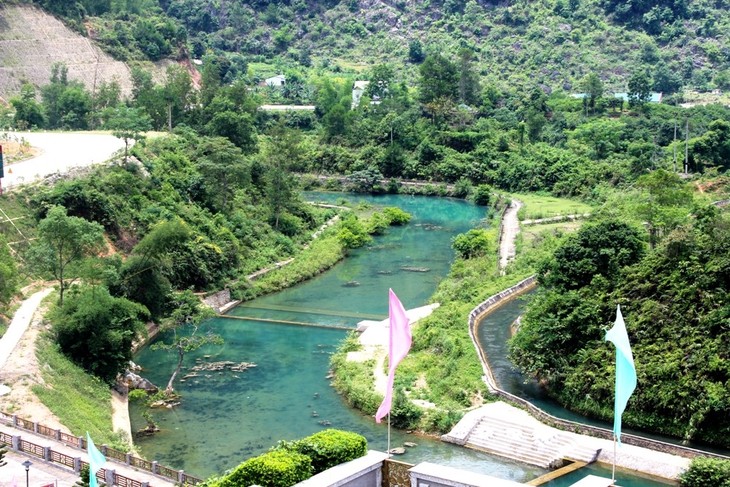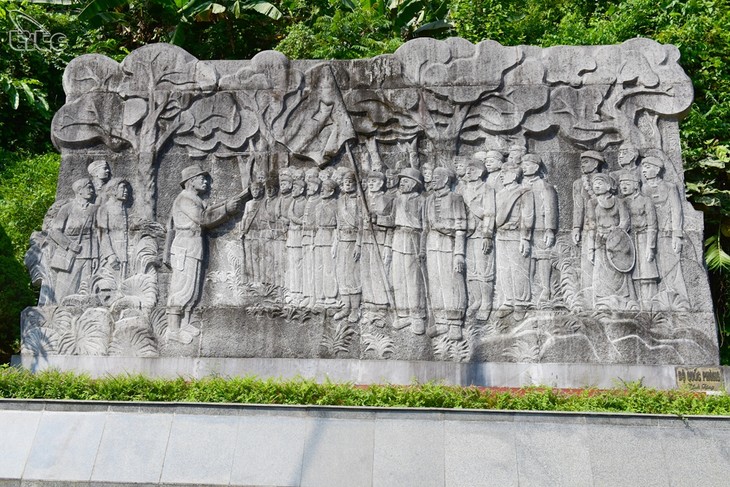(VOVWORLD) - Cao Bang province in northern Vietnam is the cradle of Vietnam’s revolutionary movements. A great number of famous sites in Cao Bang tell about Vietnam’s historical events in a timeline. These relics vividly recall memories of President Ho Chi Minh and General Vo Nguyen Giap, Vietnam’s prominent military leader.
Of 214 historical relics in Cao Bang province, three were honored as special national historical sites. They are Pac Bo cave, Tran Hung Dao forest, and the monument for the 1950 border victory site.
Pac Bo in Ha Quang village, is the first destination of a trip to Cao Bang. Pac Bo, 52 kilometers north of Cao Bang city, means “river head” in the Tay and Nung ethnic language. It was here that President Ho Chi Minh returned to Vietnam in 1941, after a 30-year journey of national salvation. Pac Bo offers a close look into a significant period of Ho Chi Minh’s revolutionary career and Vietnam’s history. It has some beautiful scenery. Turquoise water flows from Lenin spring to the foot of Karl Marx mountain. A wood platform where Ho Chi Minh slept can be seen in Coc Bo cave. There you can also find a fire that warmed him up at night and a rock table where he worked. Pac Bo was recognized as special national historical site in 2012.
 The Pac Bo special national historical site (Photo: baodantoc.vn) The Pac Bo special national historical site (Photo: baodantoc.vn) |
Be Thi Mai, a care taker of President Ho Chi Minh temple, said, “A number of war veterans, regardless of their disabilities, manage to visit all the sites where President Ho Chi Minh worked and lived. They burst into tears at the entrance as they see the hardships the President endured. They told me that they were brutally tortured but their physical pains were nothing compared to what the President suffered.”
As the trip continues, visitors are taken to Tran Hung Dao forest in Nguyen Binh district, which is associated with the life and revolutionary career of General Vo Nguyen Giap. On December 22, 1944, he inaugurated the Vietnam Propaganda and Liberation Army, the predecessor of today’s Viet Nam People’s Army. They lived and worked at Tran Hung Dao forest, a complex site of the Army’s inauguration venue, shack and kitchen cottages, Tham Khau cave – a communications station and dining room for revolutionists, Phai Khat post where the Vietnam Propaganda and Liberation Army fought and won its very first battle, Na Ngan post which marked their second victory, and Va Pha where classrooms and training courses were opened in February, 1944.
Le Binh, a tourist from Hanoi, told VOV, “This is the first time I’ve ever been to Cao Bang province and these historical relics. I know about them through books, newspapers, and television. Today I’m emotional seeing them with my own eyes and imagining how hard our predecessors suffered to regain independence for younger generations. The more I know, the more I respect their staunchness. This trip helps me learn more about the revolutionary career of President Ho Chi Minh and General Vo Nguyen Gap.”
 An embossed sculpture of the inauguration of the Vietnam Propaganda and Liberation Army is placed at the entrance to Tran Hung Dao forest. (Photo: dulich.petrotimes.vn) An embossed sculpture of the inauguration of the Vietnam Propaganda and Liberation Army is placed at the entrance to Tran Hung Dao forest. (Photo: dulich.petrotimes.vn) |
The trip is incomplete without visiting the monument for the 1950 border victory site located in Thach An district. President Ho Chi Minh was the commander of this military offensive. This complex encompasses four relics. A monument was built atop Bao Dong mountain inside this complex where the President observed and commanded the troops.
These are great places to teach the young people about Vietnam’s revolutionary traditions and infuse them with patriotism.